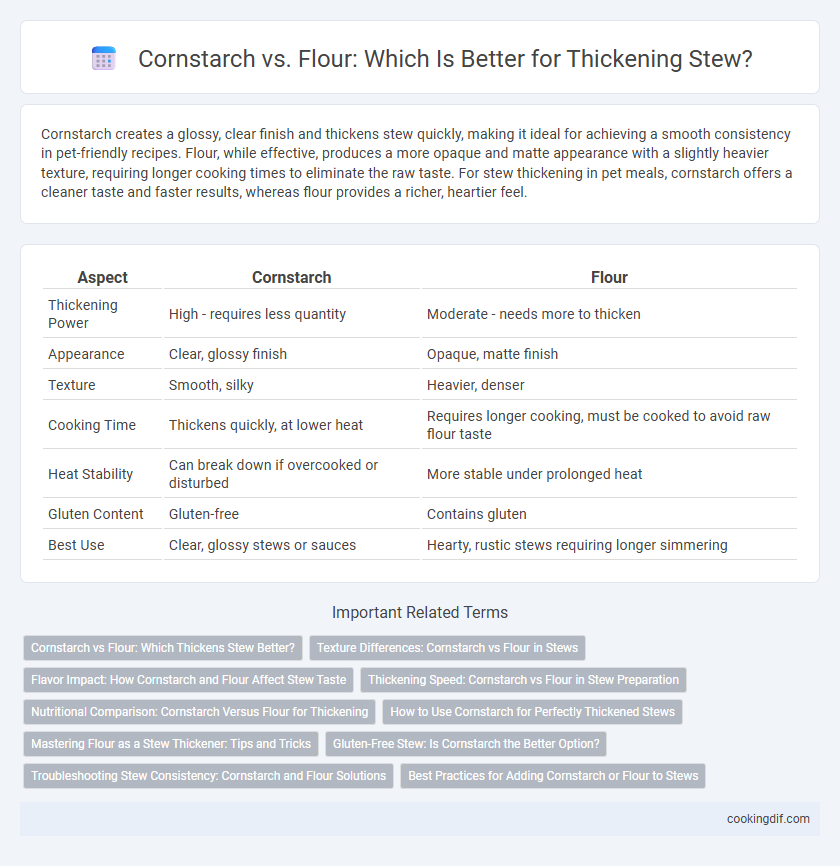Cornstarch creates a glossy, clear finish and thickens stew quickly, making it ideal for achieving a smooth consistency in pet-friendly recipes. Flour, while effective, produces a more opaque and matte appearance with a slightly heavier texture, requiring longer cooking times to eliminate the raw taste. For stew thickening in pet meals, cornstarch offers a cleaner taste and faster results, whereas flour provides a richer, heartier feel.
Table of Comparison
| Aspect | Cornstarch | Flour |
|---|---|---|
| Thickening Power | High - requires less quantity | Moderate - needs more to thicken |
| Appearance | Clear, glossy finish | Opaque, matte finish |
| Texture | Smooth, silky | Heavier, denser |
| Cooking Time | Thickens quickly, at lower heat | Requires longer cooking, must be cooked to avoid raw flour taste |
| Heat Stability | Can break down if overcooked or disturbed | More stable under prolonged heat |
| Gluten Content | Gluten-free | Contains gluten |
| Best Use | Clear, glossy stews or sauces | Hearty, rustic stews requiring longer simmering |
Cornstarch vs Flour: Which Thickens Stew Better?
Cornstarch provides a clearer, glossier finish and thickens stew faster than flour, making it ideal for achieving a smooth texture without altering flavor. Flour thickens more gradually and imparts a richer, slightly opaque consistency, which enhances the stew's heartiness but can introduce a subtle floury taste if not cooked thoroughly. Choosing cornstarch or flour depends on the desired stew clarity, cooking time, and flavor preference, with cornstarch favored for light, quick-thickening and flour preferred for a traditional, robust texture.
Texture Differences: Cornstarch vs Flour in Stews
Cornstarch creates a glossy, smooth texture in stews, resulting in a lighter, more translucent thickness compared to flour. Flour thickens stews with a denser, creamier consistency and can impart a slightly grainy or opaque appearance. The choice between cornstarch and flour affects the stew's mouthfeel and clarity, with cornstarch providing a silkier finish and flour offering a heartier, more rustic texture.
Flavor Impact: How Cornstarch and Flour Affect Stew Taste
Cornstarch thickens stew without altering its flavor, providing a clear, glossy finish that preserves the dish's natural taste. Flour adds a subtle, nutty undertone and can create a slightly opaque appearance, contributing a richer, more robust flavor profile to heartier stews. Choosing cornstarch or flour depends on whether a cleaner broth or a fuller, more complex taste is desired in the final stew.
Thickening Speed: Cornstarch vs Flour in Stew Preparation
Cornstarch thickens stew significantly faster than flour, often within minutes of being added to hot liquid, making it ideal for quick adjustments in consistency. Flour requires longer cooking time to eliminate its raw taste and fully thicken the stew, typically 15-20 minutes of simmering. The rapid thickening property of cornstarch provides smoother texture without prolonged cooking, whereas flour develops a more robust, hearty body with extended heat exposure.
Nutritional Comparison: Cornstarch Versus Flour for Thickening
Cornstarch contains fewer calories and carbohydrates per tablespoon compared to flour, making it a lower-calorie thickening choice for stews. Flour provides more protein and fiber, along with small amounts of vitamins and minerals, contributing to a slightly higher nutritional content. Choosing cornstarch results in a clearer, glossier finish with minimal impact on nutrients, while flour adds a heartier texture and more complex nutritional benefits.
How to Use Cornstarch for Perfectly Thickened Stews
To achieve perfectly thickened stews using cornstarch, dissolve 1-2 tablespoons of cornstarch in an equal amount of cold water before gradually stirring it into the hot stew to prevent clumping. Heat the stew while stirring until it reaches the desired thickness, usually within a few minutes as cornstarch thickens quickly and creates a glossy finish. Cornstarch offers a clear, smooth texture compared to flour, making it ideal for enhancing the stew's consistency without altering its flavor.
Mastering Flour as a Stew Thickener: Tips and Tricks
Mastering flour as a stew thickener involves properly cooking the flour to remove its raw taste and achieve a smooth texture. Create a roux by cooking equal parts flour and fat until golden, then gradually whisk in liquid to prevent lumps and ensure even thickening. This technique enhances the stew's richness while providing a stable, velvety consistency ideal for long-simmered dishes.
Gluten-Free Stew: Is Cornstarch the Better Option?
Cornstarch is a superior choice for gluten-free stew thickening because it provides a clear, glossy finish and thickens quickly without altering the flavor. Unlike flour, cornstarch is naturally gluten-free, making it ideal for individuals with celiac disease or gluten sensitivity. Using cornstarch ensures a smooth, velvety texture while maintaining the stew's original taste and dietary requirements.
Troubleshooting Stew Consistency: Cornstarch and Flour Solutions
Cornstarch provides a clear, glossy finish and thickens stew quickly at lower temperatures, making it ideal for achieving a smooth consistency without a floury taste, but it can break down if overcooked, causing thinning. Flour offers a richer, opaque texture and a more stable thickening effect during long simmering, although it requires a fat roux for proper integration to avoid lumps or a raw flour flavor. For optimal stew consistency, use cornstarch for quick thickening near the end of cooking and flour for prolonged simmering, adjusting amounts carefully to prevent overly thick or thin results.
Best Practices for Adding Cornstarch or Flour to Stews
For stew thickening, cornstarch creates a clear, glossy finish and should be mixed with cold water to form a slurry before adding it slowly to simmering stew to avoid clumps. Flour thickens with a richer texture but requires cooking longer to remove the raw taste, often best added as a roux or blended with fat before incorporation. Both thickeners demand gradual stirring and controlled heat to achieve the ideal consistency without over-thickening or clumping.
Cornstarch vs flour for stew thickening Infographic

 cookingdif.com
cookingdif.com